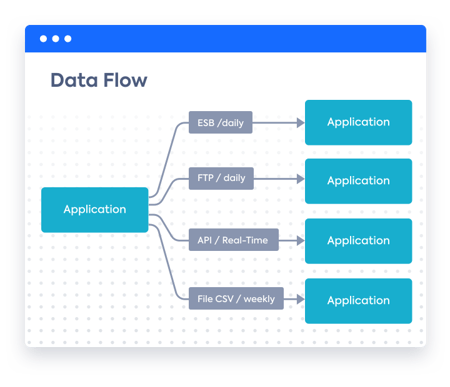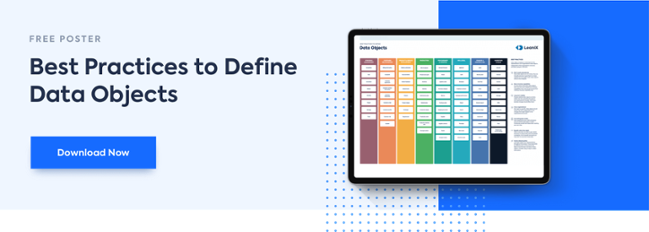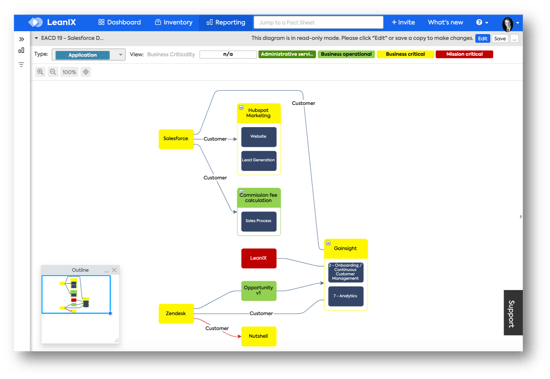Introduction
Global business transformation processes demand that information be shared quickly and efficiently across many different software, tasks, and applications. LeanIX internal research indicates that large enterprises with more than €1 billion in annual revenue have an average of 650 applications deployed at one time. The 10% largest companies have an average of a staggering 3400 applications.
Many times these applications or software systems are not created to work with each other without the help of specified integration software. In these cases, it is imperative to have a strong Integration Architecture system.
What is integration architecture?
Integration Architecture (IA) is a major part of every company's IT landscape, that simplifies the integration of numerous IT components and enables you to trace data flows between applications. IA changes with the advances in cross-platform utility and other development paradigms for new kinds of digital operations. Integration software breaks down silos and enables various software applications to communicate with each other.
In order to connect the different applications with each other, application programming interfaces (APIs) are used, which are specially designed to enable this kind of integration.
Integration Architecture enables you to process these applications and data objects within your IT architecture while providing and using interfaces.
Business software is not typically built to communicate with one another. Integrations between applications help to streamline processes like payroll and accounting, for example. And, since enterprises definitely need CRM applications, payroll applications, human resources applications, ERP systems, etc. - it is imperative that these applications are able to work together.
Almost all applications are built from separate components and run on different systems. If these applications cannot communicate with each other, they will produce data quality inefficiencies, redundancies, and silos, and decrease satisfaction for the end-user. Therefore, integrations are an important first step to business efficiency and growth.

Figure 1: Integration Architecture: Data Flow Example
What are the key advantages of integration architecture?
When it comes to integration architecture, it is important to understand the big picture.
Integration architecture provides many benefits for large enterprises. We have focused on the four main advantages:
- Reduction of costs
- Improved customer satisfaction
- Better management and analysis of applications
- Increased productivity in the company
Reduction of costs
The cost of operating different systems is often very high due to maintenance, upgrades, and expansions. The coordination of such activities is very time-consuming, especially if they are carried out at varying times, and is also costly. In fact, the cost of investment in support and maintenance may exceed the value of the system itself.
Integration Architecture ensures that the various products are all coordinated and provides an overview of the connections between respective applications so that costly errors can be avoided when updates affect several systems at once.
Improved customer satisfaction
By reducing the need for manual workloads, companies free up time which can then be used to focus on the customer. In today's fast-moving, digital, and highly competitive world, customer needs play a central role in business success. As soon as companies no longer meet customer requirements, an alternative option is immediately sought.
Therefore, the time gained should be invested in the analysis of customer needs and in the subsequent implementation of solutions, so that customer satisfaction will increase significantly as a result.
Better management and analysis of applications
Performing different analyses for each application is not only time-consuming but often of little use. A large number of applications within the enterprise environment will cause complications, which makes it much more difficult to analyze the big picture.
Especially in large enterprises, it is essential to get an overall view of the application and its links. However, it is almost impossible to get a clear picture if there is no smart Integration Architecture. This lack of proper analysis can make you fall behind the competition.
With Integration Architecture you can get an overall understanding of how well the company is doing and make informed decisions about future development.
Increased productivity in the company
Repeated and often redundant manual workflows lead to a highly inefficient allocation of working time, which results in losing sight of upcoming and more sustainable projects. This type of workflow occurs mainly in situations with different systems and applications that do not offer proper integrations with each other and therefore need to be processed manually.
In addition to the high amount of time required, such workflows are also prone to errors, which can lead to serious problems as soon as the first error occurs. The higher the number of different systems that need to be connected to each other, the higher the probability of errors.
Integration Architecture ensures that productivity increases dramatically by replacing repetitive error-prone workflows and automating them. If careful and error-free integration is implemented, the error rate for such integrations is reduced to almost zero, thus minimizing the risk of major failures between two or more systems.
By and large, integrations save time and reduce error-proneness, which leads to higher productivity as employees can now use their work capacities in a more targeted manner.

What is the role of an integration architect?
The main tasks of the integration architect are to maintain an efficient technical environment for all customer services, document all architectural plans, as well as provide support for all functions and the installation of system components. This includes the coordination, planning, and implementation of software integrations both internally and via third-party applications.
The integration architect also helps with the completion of all systems and supports various stakeholders with regard to system integration
Besides the main tasks of an integration architect, there are many other routine duties that apply:
- They have the responsibility for gap analysis and assessment of certain system structures
- They create data models to visualize the integrations
- They provide the means for system integration taking into consideration the source
- They develop and implement their own integration solutions based on code
- They develop data strategies and data architecture documentation
Obviously, there are many more tasks that the Integration Architect has to perform, although these tasks differ from company to company.
The integration architect does not work alone, of course, but cooperates closely with other participants within the company, such as enterprise, solution, and technical architects, as well as business owners. The integration architect also reports to senior leadership within the company, such as the CTO, in the event of larger projects.
/the-complete-overview-of-enterprise-integration-patterns-thumbnail.png?width=360&height=255&name=the-complete-overview-of-enterprise-integration-patterns-thumbnail.png)
/the-complete-overview-of-enterprise-integration-patterns-thumbnail.png?width=450&height=318&name=the-complete-overview-of-enterprise-integration-patterns-thumbnail.png)









